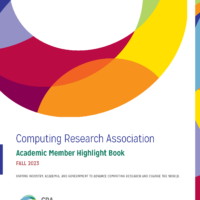Expanding the Pipeline: “Regular” CS x Inclusive Design
By Rosalinda Garcia (Oregon State University), Margaret Burnett (Oregon State University), and Patricia Morreale (Kean University)
What happens if CS faculty teach inclusive design skills throughout core undergraduate CS courses? What might the outcomes of an integrated contiguous experience be? Funded by the National Science Foundation (NSF), we have developed a new broadening participation in computing (BPC) practice called Embedded Inclusive Design.
The practice has two BPC goals:
- An immediate increase in retention in CS programs, through student behavior changing student inclusivity toward each other.
- A longer-term change in the inclusivity of the software these future CS practitioners build.
To succeed at these two goals requires integrating inclusivity skill-building into CS students’ everyday CS classes—and that is the essence of how this BPC practice works.
The Embedded Inclusive Design practice is novel in two key ways. First, it can span the entire 4-year curriculum and is appropriate for even non-HCI courses. The reason for this is to avoid disconnecting such concepts from the rest of CS and to allow the changes to any one course to be minimal. Second, the practice involves both faculty and students as active producers of inclusivity. While faculty are responsible for embedding inclusive design into their course, students are responsible for applying their inclusive design knowledge to create more inclusive peer interactions and software.
The practice needs to be powered by some inclusive design method. We have been using GenderMag (Gender Inclusiveness Magnifier) method which is used to find, fix, and/or avert inclusivity bugs. The GenderMag method provides a reasonable starting place because it has been used in practice by technologists across the world and because of its accuracy (low false-positives rate). However, the Embedded Inclusive Design BPC practice is general enough to be powered by any other evidence-based inclusive design method. The selected inclusive design method is then used as a basis, not an atomic unit. CS faculty choose any of the elements they want and integrate them however they want into their own CS/IT courses (https://bpcnet.org/resources/gendermag-teach/).
We have used this practice at Kean University and Oregon State University. At Kean, the CS faculty used the practice in a coordinated effort to embed elements of inclusive design across their 4-year undergraduate (in-person) computer science and IT programs. This effort included a variety of courses such as CS1, Software Engineering, and Capstone. At Oregon State, individual CS faculty have used the approach in in-person and asynchronous online classes such as Software Engineering and Databases.
Our implementation of this practice began with a workshop, which is now available as a free online course. Throughout the workshop, faculty learned inclusive design via GenderMag and were guided through embedding elements of inclusive design into their own course content. These embeddings vary by course level to build students’ knowledge gradually. For example, introductory courses at Kean (e.g. CS1) discuss inclusive design concepts such as designing for someone other than oneself and provide exercises such as small modifications to the standard assignments for those classes. (For example, instead of “create a webpage to do <x>” the assignment could be “create a webpage to do <x> and explain how someone like <Name> would use it.”) Later courses add material on diverse humans’ variety of problem-solving styles, and students consider whether/how the software they are building will support this diversity. Ultimately, students use the full inclusive design method to design and evaluate their senior projects. This progression allows students to build their understanding of inclusive design over time with minimally invasive changes to course material.
A year-long investigation into effects on students has shown positive results on students’ skills and on the education climate. For example, on average, 70% of the students earned as high a grade on their inclusive design work as they did on their final grade. Retention also increased by 10%. On student questionnaires, students reported a significant improvement to climate, including improved teamwork and improved ratings of instructor inclusivity. Overall, based on the data gathered, the embedded inclusive design curriculum has been proven to be both feasible to use and advantageous to students.
Resources for implementing this practice and learning more about GenderMag can be found in the BPCnet Activity Library:
This material is based upon work supported by the National Science Foundation under Grant No. 2042324 and 2042341.
Contact Author: P. Morreale (pmorreal@kean.edu)









